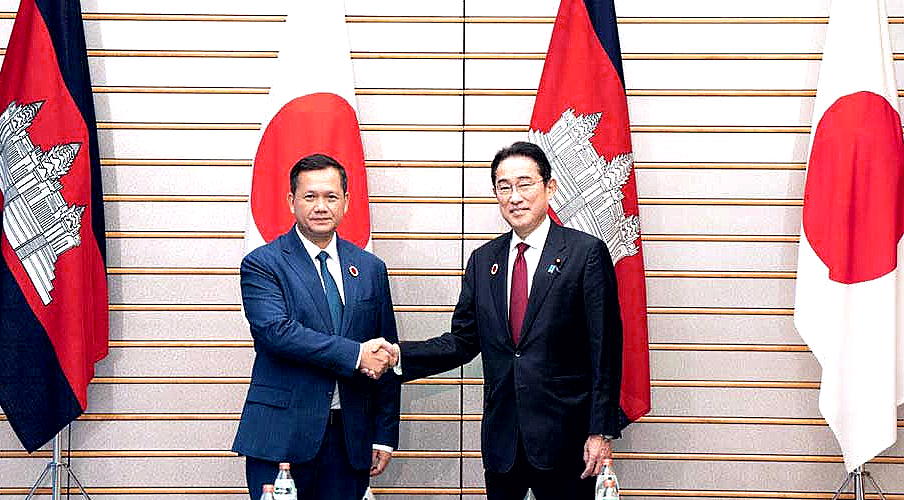
After the recent visit of Prime Minister Hun Manet to Japan for the ASEAN-Japan commemorative summit, there are discussions among Cambodian scholars about the impact of Japan in ASEAN as well as in Cambodia.
Japan is very active in supporting Cambodia and other ASEAN member states while China has been working closely with almost all ASEAN countries.
Both Japan and China are very important for Cambodia. How should Cambodia balance its foreign relations among the two good friends who are competing with each other?
Japan has traditionally dominated the ASEAN economy with its cutting-edge technology, robust industrial sector and well-known international brands.
Japanese businesses have made large investments in a number of sectors, including the development of infrastructure, electronics and the automobile industry.
Because of their reputation for excellence and their emphasis on quality and dependability, buyers highly value Japanese products.
China, on the other hand, has grown into a powerful player in the ASEAN region thanks to its enormous population and quickly expanding economy.
Chinese businesses have become more prevalent in a variety of industries, including energy, construction and telecommunications.
China’s Belt and Road Initiative (BRI), which encourages trade connections and infrastructure development among member nations, has further cemented its power.
Comprehending the economic sway of China and Japan is crucial for Cambodia in order to develop winning tactics.
By evaluating the advantages and disadvantages of these two economies, Cambodia can find possible areas for cooperation and rivalry.
It may take advantage of China’s market potential and infrastructure development plans while using Japan’s technological know-how and investment resources.
Cambodia can improve its competitiveness by studying the tactics China and Japan use.
For example, incorporating Japan’s emphasis on innovation and quality might assist Cambodian enterprises in standing out in the marketplace.
In a similar vein, trade and investment opportunities may arise from supporting China’s connectivity projects.
But Cambodia also needs to be wary of the possible threats posed by China’s and Japan’s economic clout.
It needs to make sure that the influx of foreign businesses doesn’t overshadow or undermine its domestic sectors.
Priority should be given to balancing economic cooperation with these two countries while defending Cambodia’s interests at home.
Rich natural resources, including farmland, minerals and fisheries, are among Cambodia’s advantages. This gives sectors like manufacturing, tourism and agriculture a solid basis.
Cambodia also has the advantage of having a young, reasonably priced labour population, which attracts global firms looking for low-cost production and outsourcing.
However, there are certain shortcomings in Cambodia that must be rectified. Its low technological capabilities are one of these weaknesses, which might impede innovation and competitiveness in high-tech businesses.
With their superior technological know-how and capacities for research and development, China and Japan shine in this field.
Cambodia faces additional difficulties due to its very tiny domestic market in comparison to China and Japan.
Due to the potential for this to reduce its customer base and scale economies, it is critical that Cambodian companies look into exporting and build robust global networks.
Working with Chinese and Japanese businesses can be advantageous for Cambodia as well.
Through the establishment of strategic alliances and joint ventures, Cambodia can obtain access to cutting-edge resources, capital and knowledge. By doing so, it will be able to close the technology divide and become more competitive overall in the ASEAN market.
Cambodia should also spend money on educational and career-training initiatives in order to create a workforce that is qualified to fulfil the needs of developing markets.
The country can encourage innovation and draw in higher-value investments by developing a knowledge-based economy.
It can efficiently navigate this competitive landscape by concentrating on particular industries where it has a comparative advantage, thereby leveraging its capabilities.
For example, Cambodia may leverage its agricultural resources and encourage organic farming methods to meet the increasing demand for food products that are both nutritious and sustainable.
Cambodia can also benefit from its youthful and energetic labour force.
The skilled labour pool in the nation is expanding, especially in sectors like manufacturing, technology and textiles.
Cambodia can maintain the competitiveness of its workforce and its ability to adjust to the changing demands of the market by making investments in education and vocational training programmes.
This will draw in outside capital and promote the expansion of local businesses, enhancing the overall economic development of the country.
Infrastructure plays a pivotal role in facilitating trade, logistics and connectivity, which are vital for attracting foreign investments.
Well-developed transportation networks such as roads, ports and airports not only enable efficient movement of goods and services but also reduce costs and improve accessibility.
This, in turn, creates an attractive environment for foreign investors looking to establish or expand their operations in Cambodia.
To effectively attract foreign investments, Cambodia needs to prioritise infrastructure development in key areas such as transportation, energy, telecommunications and digital infrastructure.
Collaborating with international partners and leveraging their expertise and resources can expedite the process and ensure the implementation of high-quality infrastructure projects.
Corruption is another big problem for Cambodia. Businesspeople always search for information related to Cambodia before they come to invest in the country, so the government should take real action to attract foreign investors.
Lastly, maintaining a business-friendly environment, reducing regulations, and ensuring transparency and good governance are vital for attracting foreign investors and building a conducive atmosphere for economic growth.
Cambodia’s journey in navigating the ASEAN competition requires a strategic approach that encompasses leveraging strengths, investing in infrastructure and human capital, fostering collaboration, embracing innovation and ensuring a conducive business environment.
By applying these important takeaways, Cambodia may pave its path to success and prosper in the dynamic ASEAN market.
(Seun Sam is Researcher at the Royal Academy of Cambodia.)
ADVERTISEMENT
ADVERTISEMENT








































